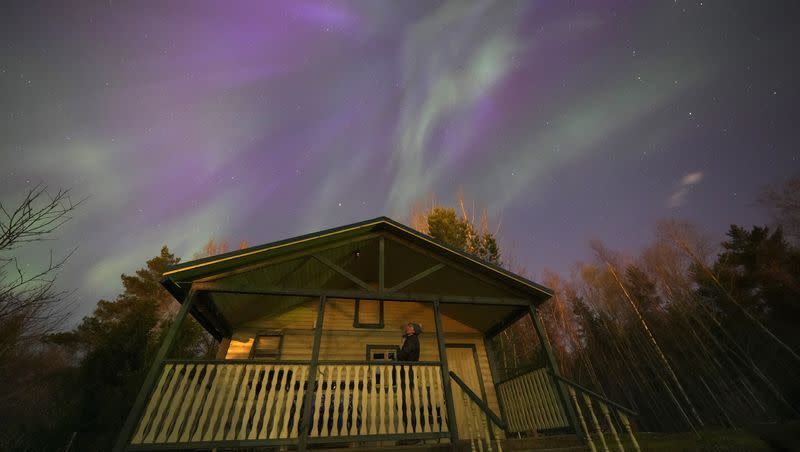How a recent geomagnetic storm affected the aurora borealis

On Sunday, a strong geomagnetic storm caused the northern lights to display their colors as far south as Virginia.
An X user shared a time-lapse video of the Sunday night sky in Lebanon, Virginia.
A quick timelapse just after sunset of the SAR arc overlaid to the actual soundtrack I heard for 4 hours on the ridge. Turn the volume up and enjoy! #vawx
📍Lebanon, Va pic.twitter.com/ZDLNU6xcch— Billy Bowling 𝕏 (@babowling12) November 6, 2023
The lights were strongest in Europe and Asia, but they could also be seen in Ukraine, as shown in posts on X, the site formerly called Twitter.
Northern Lights over Stonehenge last night 😍✨#aurora #auroraborealis #northernlights #stonehenge
Photo credit Stonehenge Dronescapes on FB 👏👏👏 pic.twitter.com/aFh2XWOME5— Stonehenge U.K (@ST0NEHENGE) November 5, 2023
An aurora above Ukraine tonight pic.twitter.com/DrgjSE6a4N
— Mira of Kyiv 🇺🇦 (@reshetz) November 5, 2023
What happens during a geomagnetic storm?
Ryan French, a British solar astrophysicist at the National Solar Observatory, said on X that an event called a filament eruption started a chain reaction that led to Sunday’s bright and widespread display of lights.
Yesterday’s filament eruption, captured by the @NatSolarObs GONG network in H-alpha! This eruption is forecast to impact Earth tomorrow, with heightened aurora at high latitudes likely. #spaceweather pic.twitter.com/mVz3jJXLpl
— Dr. Ryan French (@RyanJFrench) November 4, 2023
A filament is a cooler region on the sun’s surface, per the National Environmental Satellite, Data and Information Service. When an eruption happens, it hurtles clouds of plasma and magnetic fields called coronal mass ejections, or CMEs, into the solar system.
If these tangled balls of plasma hit the earth, it creates a geomagnetic storm that congregates about the north and south poles of the planet, according to Space.com.
Sunday’s geomagnetic storm was forecast by the Space Weather Prediction Center in advance as a “moderate” storm registering a level 2 on a scale from 1 to 5, reported The Washington Post. The storm ended up stronger than expected and reached a level 3, making it a “strong” storm.
Do geomagnetic storms cause aurora borealis?
Since geomagnetic storms hit earth’s upper atmosphere with charged particles, they can also amplify the usual aurora borealis (northern lights) and aurora australis (southern lights), per the National Weather Service.
Do geomagnetic storms affect people?
Most of the time, flares and CMEs don’t make it to the earth’s surface and don’t affect people’s health directly, per NASA. If stronger CMEs or geomagnetic storms do occur, it’s more likely that particles can break through the atmosphere but the storms still don’t greatly increase the Earth’s normal radiation levels.
Do geomagnetic storms affect phones?
Large geomagnetic storms have the most potential to affect technology, power grids and other electric power transmission, per the National Weather Service. If a large enough storm, such as one that occurred in September 1859 called the Carrington Event, happens, then there would be “significant impacts on our technology,” according to NWS.
Phones and commercial communications, radios, and weather forecast equipment can be affected and damaged by geomagnetic storms, per NWS. Blackouts can also be a result.
Related
Aurora borealis sightings in the United States
Across the United States in places like Wyoming, North Carolina and Oklahoma, sightings of the aurora borealis were posted on X.
The aurora, the core of the milky way, and a small Taurid meteor (in the milky way) in this single photograph from last night. This was not visible to the naked eye, but a long exposure photo brought it all out nicely. pic.twitter.com/t4qSA9MxGy
— Asheville Pictures (@AshevillePictu1) November 6, 2023
A brief spell of pink pillar aurora under the SAR arc in Northern Oklahoma last night. 11/06/23 4.00utc pic.twitter.com/NTOTOBk0M4
— Paul M Smith (@PaulMSmithphoto) November 6, 2023
The #northernlights have made an appearance at our office this morning. #wywx #Auroraborealis pic.twitter.com/5WjBvDSr2i
— NWS Riverton (@NWSRiverton) November 5, 2023

